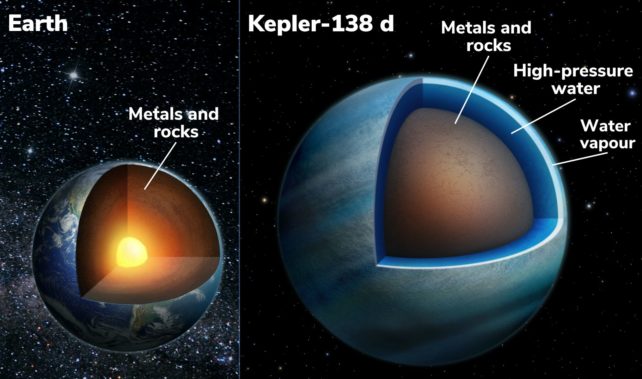Two worlds orbiting a tiny star 218 light-years away appear to be of a kind unlike anything we have in our Solar System.
The exoplanets are named Kepler-138c and Kepler-138d. Both are around 1.5 times the radius of Earth, and both appear to be soggy worlds consisting of thick, steamy atmospheres and insanely deep oceans, all wrapped around a rocky-metallic interior.
“We previously thought that planets that were a bit larger than Earth were big balls of metal and rock, like scaled-up versions of Earth, and that’s why we called them super-Earths,” says astronomer Björn Benneke of the University of Montreal.
“However, we have now shown that these two planets, Kepler-138c and d, are quite different in nature: a big fraction of their entire volume is likely composed of water. It is the first time we observe planets that can be confidently identified as water worlds, a type of planet that was theorized by astronomers to exist for a long time.”
A recent analysis of another world found that it could be a water world, but follow-up observations will be needed to confirm. According to the researchers, their work on Kepler-138’s two oceanic planets is less uncertain.
Working out what planets outside our Solar System (or exoplanets) are made of usually requires quite a bit of detective work. They’re very far away and very dim compared to the light of the stars they orbit; direct images are very hard to obtain and subsequently very rare, and don’t show much detail.
The composition of an exoplanet is usually inferred from its density, which is calculated using two measurements – one taken from the eclipsing (or transit) of the star’s light by the planet and the other from the star’s radial velocity or ‘wobble’.
The amount of starlight that gets blocked by the transit tells us the size of the exoplanet, from which we get a radius. Radial velocity is induced by the gravitational tug of the exoplanet, seen as a regular but very small expansion and contraction of the wavelength of the star’s light as it gets pulled about. The amplitude of this movement can tell us how much mass an exoplanet has.
Once you have an object’s size and mass, you can calculate its density.
A gaseous world, like Jupiter or even Neptune, will have a relatively low density. Rocky worlds that are rich in metals will have higher densities. At 5.5 grams per cubic centimeter, Earth is the densest planet in our Solar System; Saturn is the least dense, at 0.69 grams per cubic centimeter.
Transit data show Kepler-138c and Kepler-138d have radii 1.51 times that of Earth, and measures of their respective tugs on Kepler-138 give us masses of 2.3 and 2.1 times that of Earth, respectively. Those characteristics, in turn, give us a density of around 3.6 grams per cubic centimeter for both worlds – somewhere between a rocky and a gaseous composition.
That’s pretty close to the Jovian ice moon Europa, which has a density of 3.0 grams per cubic centimeter. It happens to be covered by a liquid global ocean underneath an icy shell.
“Imagine larger versions of Europa or Enceladus, the water-rich moons orbiting Jupiter and Saturn, but brought much closer to their star,” says astrophysicist Caroline Piaulet of the University of Montreal, who led the research. “Instead of an icy surface, Kepler-138c and d would harbor large water-vapor envelopes.”
According to the team’s modeling, water would make up more than 50 percent of the exoplanets’ volume, extending down to a depth of about 2,000 kilometers (1,243 miles). Earth’s oceans, for context, have an average depth of 3.7 kilometers (2.3 miles).
But Kepler-138c and Kepler-138d are much closer to their star than Earth. Although that star is a small, cool red dwarf, that proximity would make the two exoplanets much, much hotter than our world. They have orbital periods of 13 and 23 days, respectively.
This means that the oceans and atmospheres on these worlds are unlikely to look much like our ocean, the researchers say.
“The temperature in Kepler-138c’s and Kepler-138d’s atmospheres is likely above the boiling point of water, and we expect a thick, dense atmosphere made of steam on these planets,” Piaulet says.
“Only under that steam atmosphere there could potentially be liquid water at high pressure, or even water in another phase that occurs at high pressures, called a supercritical fluid.”
Alien, indeed.
The research has been published in Nature Astronomy.
